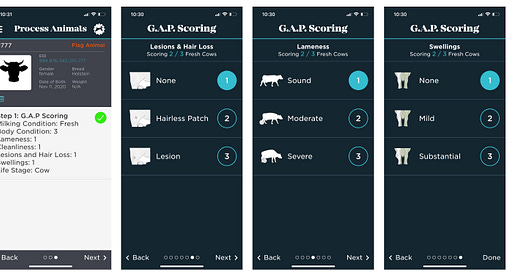Activity monitoring start-up partners with animal welfare label to document compliance
Activity monitoring start up HerdDogg recently announced it has partnered with Global Animal Partnership (G.A.P.), an animal welfare standard and labeling organization, to provide a digital solution to the on-farm animal assessment scoring requirements of G.A.P.’s dairy standard.
The group’s animal welfare standard covers the animal’s entire life (breeding through lactation and through subsequent dry periods and calvings). They will also certify farms at one of five levels based on certain practices a dairy may employ. For example, the lowest certification level prohibits tiestalls and requires pair-raising of calves. Medium level certification requires outdoor access for all cattle. The standard’s highest level of certification requires cattle be on pasture for 200 days a year and that calves stay with their dam until weaning at 24 weeks.
“HerdDogg’s partnership with G.A.P. … establishes a new standard for the digital capture and analysis of animal welfare metrics,” said Melissa Brandao, founder and CRO of HerdDogg. “We are thrilled to be a part of this as a significant step towards the overall improvement in farm animal care and reporting accuracy while reducing a producer’s time spent completing paperwork.”
According to the American Society for the Prevention of Cruelty to Animals’ website, there are not yet any dairies that are G.A.P. certified.
Read more about G.A.P.’s dairy standard here.
Behind the scenes: Building a Dairy Brain
I recently completed a podcast for Progressive Dairy magazine about the University of Wisconsin’s Dairy Brain project. In the episode, researcher Steve Wangan discusses the challenges of building an analytics platform for dairies and who should own data in the dairy industry.
Listen to the podcast here.
Two cow tech startups among Top 10 Farm Bureau innovators
Farm Bureau recently announced the 10 companies that will compete in its annual innovation challenge. Two of the companies selected work in the cow tech space.
Caravan Tech – This company provides an ecosystem of LoRaWan (long range wide area network) sensors, boluses and antennas to track cattle geolocation and animal behavior. Data is synced from sensors through cloud-based storage to desktop-based software or a smartphone app. Read more about the company here.
ExciPlex – This company has developed a novel, photochemical diagnostic technology for the detection of mycotoxins in animal feed. Read more about the company here.
All of the competing companies will receive pitch training this fall and compete at Farm Bureau’s annual convention in January. The top company selected in the challenge will receive $50,000. Learn more about the competition and the other ag technologies that are competing here.
‘Data is the dairy industry’s future’
Texas dairyman Donald De Jong opened the VAS virtual Connect Summit last week with a challenge to the dairy industry and its vendors.

“In the next 30 years, buckle up, the dairy industry is changing, and it’s going to change fast,” he said during opening comments for the two-day online conference.
“We have to look to ourselves and be accountable for everything we do, measure what we do, how we do it, and be able to be as transparent as possible. Our consumers are going to want – and require – that we are able to demonstrate how we handle our animals, how we interact with the environment, how we care for our team members.”
Data collection and transparency is what De Jong said needs to change in the industry moving forward.
“Complacency has no place in what we're doing.”
De Jong also talked about the unique manure effluent treatment system being used on his farm. (Read more about it here.)
“The future is nothing to be afraid of, as long as we understand who we are,” De Jong concluded. “We must stick to those core principles that are non-negotiable: When we take care of the cows, the cows are going to take care of us.”
USDA: 77 percent of farmers own or use a smartphone
Read about the connectivity of farmers as reported in the USDA’s 2021 survey of U.S. farm internet access and computer usage. Also see where Internet connection speeds in rural farm areas fall below the FCC’s current benchmark for fixed broadband service (25 Mbps download, 3 Mbps upload). Hint: There’s a lot of places. Check out all the red below.

What you’re missing if you’re not a paid subscriber …
The following two articles come from recent weekly posts available only to Cow Tech Report paid subscribers. Subscriptions are $99 a year or $9.99 a month. Subscribe now to gain access to these articles and other past exclusive content.
A vaccine against methane emissions
Not all new cow technologies have computer chips or robotic parts. Biologic research and development also qualifies as cow tech. New Zealand researchers are applying rumen microbial genome mapping and saliva-based immunity to attempt to create a vaccine that would limit methane emissions from cattle.
When does a cow tech company become mainstream?
Read how I bracket and correlate common technology adoption terminology and stages, such as the Gartner Hype Cycle and normal distribution adoption curves, specifically for the cow tech industry.
Profit projections from ZISK
Projected profitability for two dairy herd sizes have IMPROVED in profit projections from ZISK.
ZISK is a profit-projection smartphone app that tracks individual dairy farm profitability based on current CME board prices. Projections for a 1,000-cow dairy producing an average of 80 pounds of milk per cow and a 2,500-cow dairy producing an average of 85 pounds of milk per cow are provided.
12-month dairy farm profit projections (as of Oct. 21, 2021):
1,000-cow dairy = $509,590 (UP about $122,750 since the beginning of October)
2,500-cow dairy = $2.014 million (UP about $883,000 since the beginning of October)






